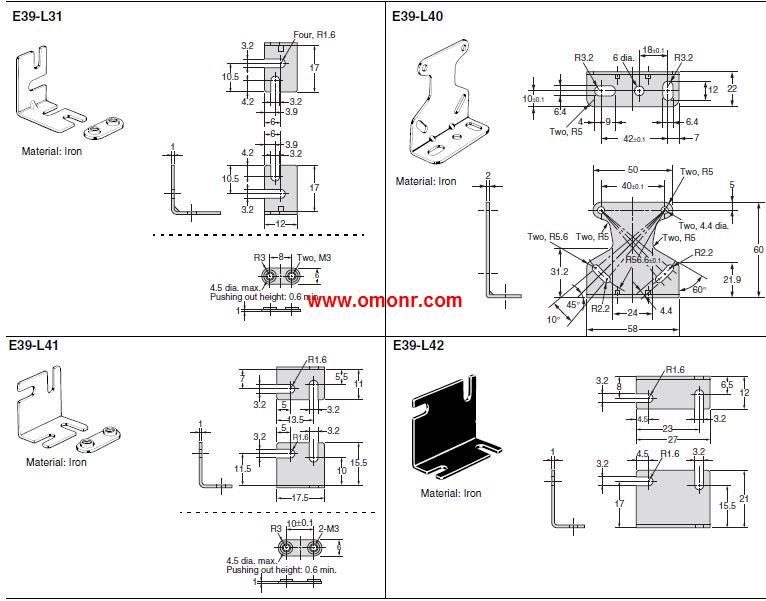Home
>> Products
>> OMRON
>> Sensor
>> Photoelectric sensor
>> Photoelectric sensor peripheral equipment
>> E39-L187 | OMRON Mounting Brackets E39-L187
E39-L187 | OMRON Mounting Brackets E39-L187
OMRON E39-L187 Manual And Instructions
E39-L187 datasheetPDF datasheet
OMRON E39-L187 Product information and technical parameters:
Brand: OMRON
Name: Mounting Brackets
Model: E39-L187
Fitting materials: Stainless steel(SUS304).
Count: 1 .
Accessories: Description, Phillips screw Nut plat;
Material, Stainless steel Stainless steel;
Count, 2, 1.
Applicable sensor (mounting pitch on sensor side): E3NC-SH250H,
E3NC-SH250, E3NC-SH100.
Page: Dimensions, 16.
...More relevant models >>>>
E39-L187 datasheetPDF datasheet
OMRON E39-L187 Product information and technical parameters:
Brand: OMRON
Name: Mounting Brackets
Model: E39-L187
Fitting materials: Stainless steel(SUS304).
Count: 1 .
Accessories: Description, Phillips screw Nut plat;
Material, Stainless steel Stainless steel;
Count, 2, 1.
Applicable sensor (mounting pitch on sensor side): E3NC-SH250H,
E3NC-SH250, E3NC-SH100.
Page: Dimensions, 16.
Size: M12 (Brass); Single; Shielded.
Sensing distance: 5 mm.
Connecting method (See note 1.): M12 Connector.
Body length: Long.
Output configuration: NPN.
Operation mode NC.
A new generation in global applications. Advanced algorithms to achieve ultra high speed and ultra high flexibility
In the past, the visual sensor is more difficult to check; the location becomes very simple!
QUEST text check OMRON E39-L187 E39-L187
Precision picture comparison.
High speed production line speed, more and more stringent quality requirements.
Does not need to stop the production line, carries on the non stop adjustment. Item: Advanced models, External input models.
Functions: Remote setting, Counter, Differential operation OMRON E39-L187.
Model: NPN output.
Variable Laser Beam for Spot, Line, or Area Detection.
Long-distance detection (diffuse reflective: 1 m, retro-reflective: 7 m).
Beam shape selectable from spot, line, and area types to match various applications.
Adjustable spot diameter.
Adjustable optical axis.
The E3DC-LDA0, which supports the EtherCAT Sensor.
Communications Unit and the CompoNet Sensor.
Communications Unit, is also included in product lineup OMRON E39-L187. E32-D15Z type: standard type; standard,
Specialty: plane shape; head,
Bending radius (mm): R25.
Standard test object (minimum test object) (mm) 1: (0.005),
Fiber element for meeting diversified needsE32-A09H type: special beam type; liquid level detection,
Specialty: heat resistant 150 C 3,
Bending radius (mm): R35.
Fiber element for meeting diversified needsSensing method: Retro-reflective Sensors.
Appearance: Horizontal.
Connection method: Pre-wired.
Sensing distance: 7 m.
Functions: Timer Self Diagnosis Turbo External Diagnosis.
Model: NPN output.
Ordering Information.
Built-in Amplifier Photoelectric Sensors. Remarks: Attached to each Sensor Head.
High-accuracy Detection of Metal Workpiece Displacement E39-L187.
Sensor Heads support a wide variety of applications.
Linearity can be adjusted for non-ferrous metals,
such as SUS and aluminum, using the material selection function.
Simple linearity compensation (teaching).
Easily perform calculation for two Sensors by using a Calculating Unit E39-L187.
Prevent mutual interference for up to five Units by using a Calculating Unit.
Sensing distance: 5 mm.
Connecting method (See note 1.): M12 Connector.
Body length: Long.
Output configuration: NPN.
Operation mode NC.
A new generation in global applications. Advanced algorithms to achieve ultra high speed and ultra high flexibility
In the past, the visual sensor is more difficult to check; the location becomes very simple!
QUEST text check OMRON E39-L187 E39-L187
Precision picture comparison.
High speed production line speed, more and more stringent quality requirements.
Does not need to stop the production line, carries on the non stop adjustment. Item: Advanced models, External input models.
Functions: Remote setting, Counter, Differential operation OMRON E39-L187.
Model: NPN output.
Variable Laser Beam for Spot, Line, or Area Detection.
Long-distance detection (diffuse reflective: 1 m, retro-reflective: 7 m).
Beam shape selectable from spot, line, and area types to match various applications.
Adjustable spot diameter.
Adjustable optical axis.
The E3DC-LDA0, which supports the EtherCAT Sensor.
Communications Unit and the CompoNet Sensor.
Communications Unit, is also included in product lineup OMRON E39-L187. E32-D15Z type: standard type; standard,
Specialty: plane shape; head,
Bending radius (mm): R25.
Standard test object (minimum test object) (mm) 1: (0.005),
Fiber element for meeting diversified needsE32-A09H type: special beam type; liquid level detection,
Specialty: heat resistant 150 C 3,
Bending radius (mm): R35.
Fiber element for meeting diversified needsSensing method: Retro-reflective Sensors.
Appearance: Horizontal.
Connection method: Pre-wired.
Sensing distance: 7 m.
Functions: Timer Self Diagnosis Turbo External Diagnosis.
Model: NPN output.
Ordering Information.
Built-in Amplifier Photoelectric Sensors. Remarks: Attached to each Sensor Head.
High-accuracy Detection of Metal Workpiece Displacement E39-L187.
Sensor Heads support a wide variety of applications.
Linearity can be adjusted for non-ferrous metals,
such as SUS and aluminum, using the material selection function.
Simple linearity compensation (teaching).
Easily perform calculation for two Sensors by using a Calculating Unit E39-L187.
Prevent mutual interference for up to five Units by using a Calculating Unit.
...More relevant models >>>>
Related download


 Last one:
Last one:  next one:
next one: 